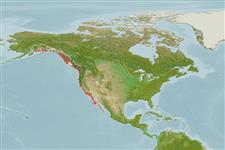Environment: milieu / climate zone / depth range / distribution range
Ecologia
marinhas demersal; intervalo de profundidade ? - 30 m (Ref. 2850). Subtropical; 61°N - 20°N, 154°W - 114°W
Eastern Pacific: northern British Columbia, Canada to central Baja California, Mexico, including Guadalupe Island, off north central Baja California.
Tamanho / Peso / Idade
Maturity: Lm ? range ? - ? cm
Max length : 22.0 cm TL macho/indeterminado; (Ref. 2850)
Descrição breve
Chaves de identificação | Morfologia | Morfometria
Espinhos dorsais (total) : 7 - 9; Raios dorsais moles (total) : 13 - 16; Espinhos anais: 3; Raios anais moles: 21 - 24; Vértebras: 31 - 34. Color variable, olive brown to coppery above lateral line, with dark pigment under each scale, bright below lateral line; dark on axil; fins either pale or rosy (Ref. 6885).
Found among giant kelp, usually up in kelp canopy. Feed on small crustaceans, especially ones that live on kelp. Also a cleaner which picks external parasites from other fishes. Usually occur in large aggregations in summer (Ref. 2850). Viviparous, female carries the developing young (Ref. 205).
Life cycle and mating behavior
Maturidade | Reprodução | Desova | Ovos | Fecundidade | Larvas
Viviparous, female carries the developing young (Ref. 205).
Eschmeyer, W.N., E.S. Herald and H. Hammann, 1983. A field guide to Pacific coast fishes of North America. Boston (MA, USA): Houghton Mifflin Company. xii+336 p. (Ref. 2850)
Categoria na Lista Vermelha da IUCN (Ref. 130435: Version 2024-1)
Ameaça para o homem
Harmless
Utilização humana
Pescarias: espécies comerciais; Aquário: Aquários públicos
Ferramentas
Relatórios especiais
Descarregue XML
Fontes da internet
Estimates based on models
Preferred temperature (Ref.
123201): 8.4 - 18.3, mean 10.7 °C (based on 229 cells).
Phylogenetic diversity index (Ref.
82804): PD
50 = 0.7500 [Uniqueness, from 0.5 = low to 2.0 = high].
Bayesian length-weight: a=0.01318 (0.00547 - 0.03178), b=3.05 (2.84 - 3.26), in cm total length, based on LWR estimates for this (Sub)family-body shape (Ref.
93245).
Nível Trófico (Ref.
69278): 3.5 ±0.50 se; based on food items.
Resiliência (Ref.
120179): Elevada, tempo mínimo de duplicação da população menor que 15 meses (tm=1).
Fishing Vulnerability (Ref.
59153): Low vulnerability (12 of 100).
Nutrients (Ref.
124155): Calcium = 155 [85, 298] mg/100g; Iron = 1.43 [0.91, 2.36] mg/100g; Protein = 19.1 [18.3, 20.0] %; Omega3 = 0.368 [0.238, 0.576] g/100g; Selenium = 20.5 [11.1, 39.0] μg/100g; VitaminA = 13.1 [4.8, 35.6] μg/100g; Zinc = 0.956 [0.691, 1.351] mg/100g (wet weight);
